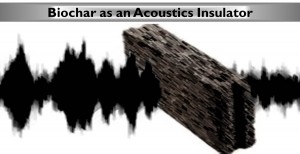Joining random LinkedIn groups does wonders for creative thinking. In my inbox today was a LinkedIn discussion email about the Acoustic Insulation (AI) market, something I have given exactly zero previous thought to in my life. Apparently this market is set to boom (or someone is desperately trying to sell Market Reports) to the tune of $4B in the not too distant future. So of course this got me thinking (about biochar). And googling (about acoustic insulation materials). Could this be the next big avenue B?
Similar to insulation used for temperature control, AI (I confess this acronym bothers me a bit, but only fellow farm folk will probably understand why!) materials are used in walls and ceilings, but also in floors. Typical materials used for AI, include rockwool, fiberglass, cotton and cellulose. How might biochar stack up as a replacement for any of these materials? Well we already know it has been used quite successfully for temperature and humidity control so it’s not a stretch to think that it could work for acoustics as well.
Let’s dig a little deeper into the sustainability of the competition though, shall we? First up is rockwool, made of ‘natural materials’ (i.e. chalk and rock). Sounds all susty, right? Wrong. There is the issue of needing 3000F to turn said solid stuff into something like cotton candy. Embodied energy = 16.8 (energy MJ per kg). Next up is fiberglass made of glass, sand, soda ash, limestone, borax and binder coatings. While its usually one of the cheaper options, it also requires a high energy production process to convert it into fibers. Cotton is up next. Mostly made from recycled jeans, it’s a tad pricey but I’ve used this stuff and it’s great. Cellulose is similar, made from recycled paper but has the added benefit that it can be composted at the end of its life!
Biochar compares nicely from an embodied energy perspective – heck it could even be made on site while building or renovating from leftover construction materials or debris while providing remote energy so it is likely much lower (dare I suggest negative…) on the embodied energy scale. Like cellulose it can be composted at the end of its life. But I think biochar could go one step further than some of the materials I’ve mentioned. I suspect biochar insulation could fairly easily be molded into different shapes for optimal silencing or simply sprayed on like a plaster. And then there is that whole topic of carbon sequestration!
I do believe biochar as an acoustic insulation material could be a resounding success! Who knows where all of this could LEED…


